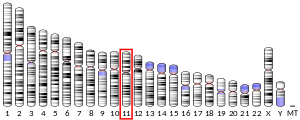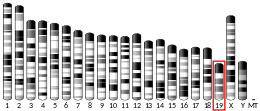FADS2
Fatty acid desaturase 2 (FADS2) is encoded by the FADS2 gene, the associated enzyme is sometimes known as FADS2 as well.[5][6] Its main associated enzyme is Delta 6 desaturase (D6D) however the human enzyme been shown to also catalyze some delta-8 and delta-4 desaturases in spite of naming conventions.[7]
Function
Fatty acid desaturase 2 is a member of the fatty acid desaturase (FADS) gene family. Desaturase enzymes cause desaturation of fatty acids through the introduction of double bonds between defined carbons of the fatty acyl chain. FADS family members are considered fusion products composed of an N-terminal cytochrome b5-like domain and a C-terminal multiple membrane-spanning desaturase portion, both of which are characterized by conserved histidine motifs. This gene is clustered with family members FADS1 and FADS2 at 11q12-q13.1; this cluster is thought to have arisen evolutionarily from gene duplication based on its similar exon/intron organization.[5]
Clinical significance
It was reported the FADS2 interacts with breastfeeding such that breast-fed children with the "C" version of the gene appear about 7 intelligence quotient (IQ) points higher than those with the less common "G" version (less than this when adjusted for maternal IQ).[8][9]
An attempt to replicate this study in 5934 8-year-old children failed: No relationship of the common C allele to negative effects of formula feeding was apparent, and contra to the original report, the rare GG homozygote children performed worse when formula fed than other children on formula milk.[10] A study of over 700 families recently found no evidence for either main or moderating effects of the original SNP (rs174575), nor of two additional FADS2 polymorphisms (rs1535 and rs174583), nor any effect of maternal FADS2 status on offspring IQ.[11]
References
- GRCh38: Ensembl release 89: ENSG00000134824 - Ensembl, May 2017
- GRCm38: Ensembl release 89: ENSMUSG00000024665 - Ensembl, May 2017
- "Human PubMed Reference:". National Center for Biotechnology Information, U.S. National Library of Medicine.
- "Mouse PubMed Reference:". National Center for Biotechnology Information, U.S. National Library of Medicine.
- "Entrez Gene: FADS1 fatty acid desaturase 1".
- Marquardt A, Stöhr H, White K, Weber BH (June 2000). "cDNA cloning, genomic structure, and chromosomal localization of three members of the human fatty acid desaturase family". Genomics. 66 (2): 175–83. doi:10.1006/geno.2000.6196. PMID 10860662.
- "MetaCyc acyl-CoA 4/6/8-desaturase".
- Gene governs IQ boost from breastfeeding.
- Caspi A, Williams B, Kim-Cohen J, Craig IW, Milne BJ, Poulton R, Schalkwyk LC, Taylor A, Werts H, Moffitt TE (November 2007). "Moderation of breastfeeding effects on the IQ by genetic variation in fatty acid metabolism". Proc. Natl. Acad. Sci. U.S.A. 104 (47): 18860–5. doi:10.1073/pnas.0704292104. PMC 2141867. PMID 17984066.
- Steer CD, Davey Smith G, Emmett PM, Hibbeln JR, Golding J (2010). "FADS2 polymorphisms modify the effect of breastfeeding on child IQ". PLoS ONE. 5 (7): e11570. doi:10.1371/journal.pone.0011570. PMC 2903485. PMID 20644632.
- Martin NW, Benyamin B, Hansell NK, Montgomery GW, Martin NG, Wright MJ, Bates TC (January 2011). "Cognitive function in adolescence: testing for interactions between breast-feeding and FADS2 polymorphisms". J Am Acad Child Adolesc Psychiatry. 50 (1): 55–62.e4. doi:10.1016/j.jaac.2010.10.010. PMID 21156270.
Further reading
- Zabaneh D, Balding DJ (2010). "A genome-wide association study of the metabolic syndrome in Indian Asian men". PLoS ONE. 5 (8): e11961. doi:10.1371/journal.pone.0011961. PMC 2915922. PMID 20694148.
- Lattka E, Illig T, Koletzko B, Heinrich J (2010). "Genetic variants of the FADS1 FADS2 gene cluster as related to essential fatty acid metabolism". Curr. Opin. Lipidol. 21 (1): 64–9. doi:10.1097/MOL.0b013e3283327ca8. PMID 19809313.
- Xie L, Innis SM (2009). "Association of fatty acid desaturase gene polymorphisms with blood lipid essential fatty acids and perinatal depression among Canadian women: a pilot study". J. Nutr. Nutr. 2 (4–5): 243–50. doi:10.1159/000255636. PMID 20395685.
- Kwak JH, Paik JK, Kim OY, et al. (2011). "FADS gene polymorphisms in Koreans: association with ω6 polyunsaturated fatty acids in serum phospholipids, lipid peroxides, and coronary artery disease". Atherosclerosis. 214 (1): 94–100. doi:10.1016/j.atherosclerosis.2010.10.004. PMID 21040914.
- Rzehak P, Thijs C, Standl M, et al. (2010). "Variants of the FADS1 FADS2 gene cluster, blood levels of polyunsaturated fatty acids and eczema in children within the first 2 years of life". PLoS ONE. 5 (10): e13261. doi:10.1371/journal.pone.0013261. PMC 2952585. PMID 20948998.
- Lattka E, Illig T, Heinrich J, Koletzko B (2009). "FADS gene cluster polymorphisms: important modulators of fatty acid levels and their impact on atopic diseases" (PDF). J. Nutr. Nutr. 2 (3): 119–28. doi:10.1159/000235559. PMID 19776639.
- Lattka E, Illig T, Heinrich J, Koletzko B (2010). "Do FADS genotypes enhance our knowledge about fatty acid related phenotypes?". Clin Nutr. 29 (3): 277–87. doi:10.1016/j.clnu.2009.11.005. PMID 19948371.
- Mathias RA, Vergara C, Gao L, et al. (2010). "FADS genetic variants and omega-6 polyunsaturated fatty acid metabolism in a homogeneous island population". J. Lipid Res. 51 (9): 2766–74. doi:10.1194/jlr.M008359. PMC 2918459. PMID 20562440.
- Koletzko B, Lattka E, Zeilinger S, et al. (2011). "Genetic variants of the fatty acid desaturase gene cluster predict amounts of red blood cell docosahexaenoic and other polyunsaturated fatty acids in pregnant women: findings from the Avon Longitudinal Study of Parents and Children". Am. J. Clin. Nutr. 93 (1): 211–9. doi:10.3945/ajcn.110.006189. PMID 21106917.
- Bokor S, Dumont J, Spinneker A, et al. (2010). "Single nucleotide polymorphisms in the FADS gene cluster are associated with delta-5 and delta-6 desaturase activities estimated by serum fatty acid ratios". J. Lipid Res. 51 (8): 2325–33. doi:10.1194/jlr.M006205. PMC 2903808. PMID 20427696.
- Glaser C, Heinrich J, Koletzko B (2010). "Role of FADS1 and FADS2 polymorphisms in polyunsaturated fatty acid metabolism". Metab. Clin. Exp. 59 (7): 993–9. doi:10.1016/j.metabol.2009.10.022. PMID 20045144.
- Steer CD, Davey Smith G, Emmett PM, et al. (2010). "FADS2 polymorphisms modify the effect of breastfeeding on child IQ". PLoS ONE. 5 (7): e11570. doi:10.1371/journal.pone.0011570. PMC 2903485. PMID 20644632.
- Merino DM, Ma DW, Mutch DM (2010). "Genetic variation in lipid desaturases and its impact on the development of human disease". Lipids Health Dis. 9: 63. doi:10.1186/1476-511X-9-63. PMC 2914715. PMID 20565855.
- Kröger J, Zietemann V, Enzenbach C, et al. (2011). "Erythrocyte membrane phospholipid fatty acids, desaturase activity, and dietary fatty acids in relation to risk of type 2 diabetes in the European Prospective Investigation into Cancer and Nutrition (EPIC)-Potsdam Study". Am. J. Clin. Nutr. 93 (1): 127–42. doi:10.3945/ajcn.110.005447. PMID 20980488.
- Koletzko B, Demmelmair H, Schaeffer L, et al. (2008). Genetically determined variation in polyunsaturated fatty acid metabolism may result in different dietary requirements. Nestle Nutr Workshop Ser Pediatr Program. Nestlé Nutrition Workshop Series: Pediatric Program. 62. pp. 35–44, discussion 44–9. doi:10.1159/000146246. ISBN 978-3-8055-8553-8. PMID 18626191.
- Segrè AV; et al. (2010). "Common inherited variation in mitochondrial genes is not enriched for associations with type 2 diabetes or related glycemic traits". PLoS Genet. 6 (8): e1001058. doi:10.1371/journal.pgen.1001058. PMC 2920848. PMID 20714348.
- Zietemann V, Kröger J, Enzenbach C, Jansen E, Fritsche A, Weikert C, Boeing H, Schulze MB (December 2010). "Genetic variation of the FADS1 FADS2 gene cluster and n-6 PUFA composition in erythrocyte membranes in the European Prospective Investigation into Cancer and Nutrition-Potsdam study". Br. J. Nutr. 104 (12): 1748–59. doi:10.1017/S0007114510002916. PMID 20691134.
- Park MH, Kim N, Lee JY, Park HY (2011). "Genetic loci associated with lipid concentrations and cardiovascular risk factors in the Korean population". J. Med. Genet. 48 (1): 10–5. doi:10.1136/jmg.2010.081000. PMID 20972250.
- Lu Y, Feskens EJ, Dollé ME, Imholz S, Verschuren WM, Müller M, Boer JM (July 2010). "Dietary n-3 and n-6 polyunsaturated fatty acid intake interacts with FADS1 genetic variation to affect total and HDL-cholesterol concentrations in the Doetinchem Cohort Study". Am. J. Clin. Nutr. 92 (1): 258–65. doi:10.3945/ajcn.2009.29130. PMID 20484448.
- Bailey SD, Xie C, Do R, et al. (2010). "Variation at the NFATC2 locus increases the risk of thiazolidinedione-induced edema in the Diabetes REduction Assessment with ramipril and rosiglitazone Medication (DREAM) study". Diabetes Care. 33 (10): 2250–3. doi:10.2337/dc10-0452. PMC 2945168. PMID 20628086.



